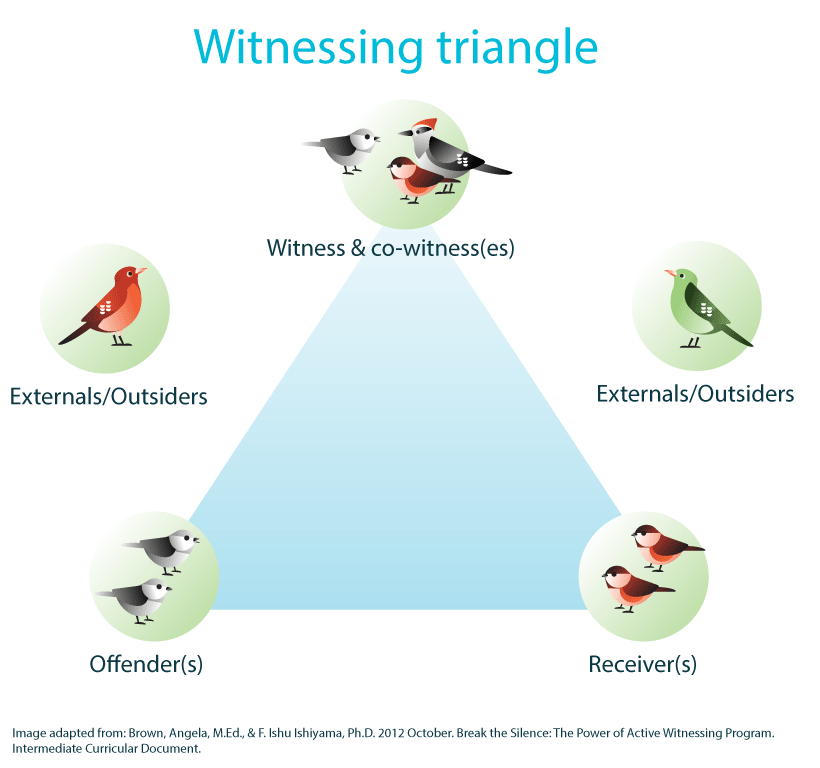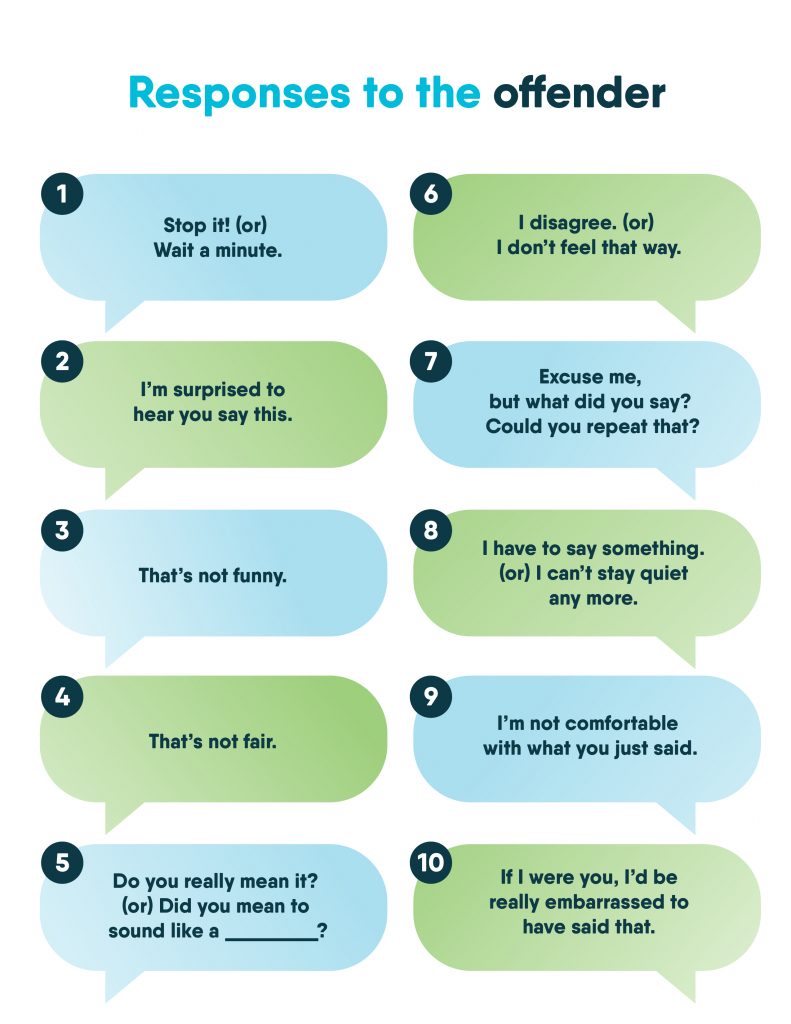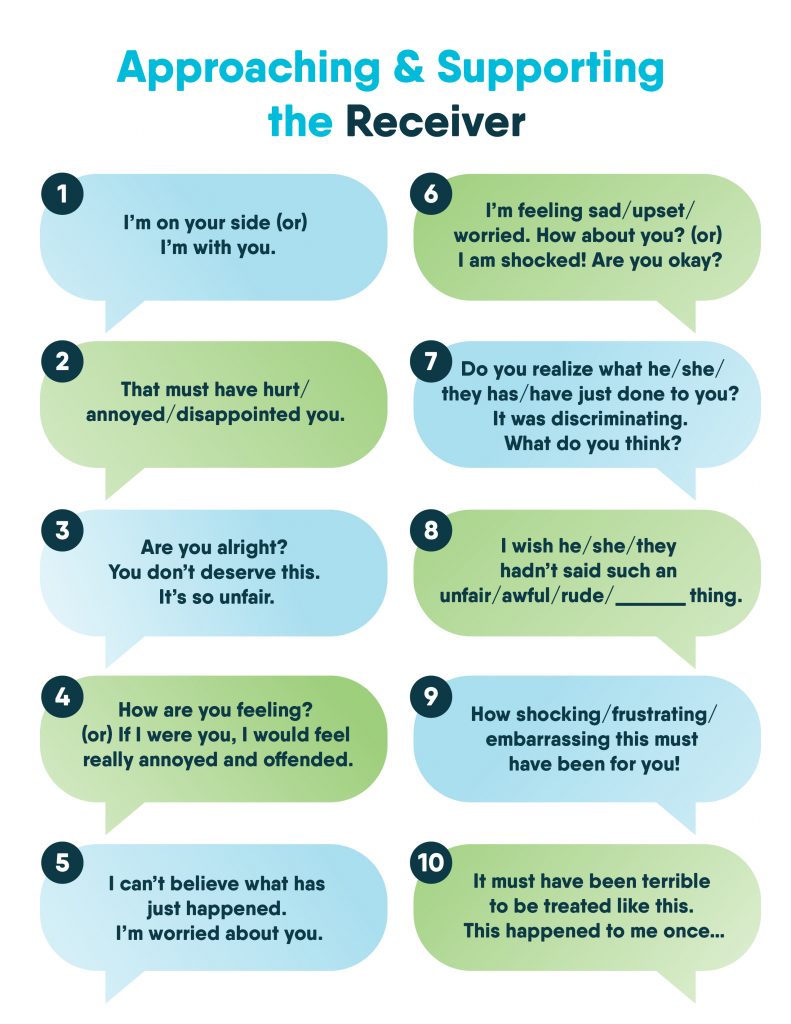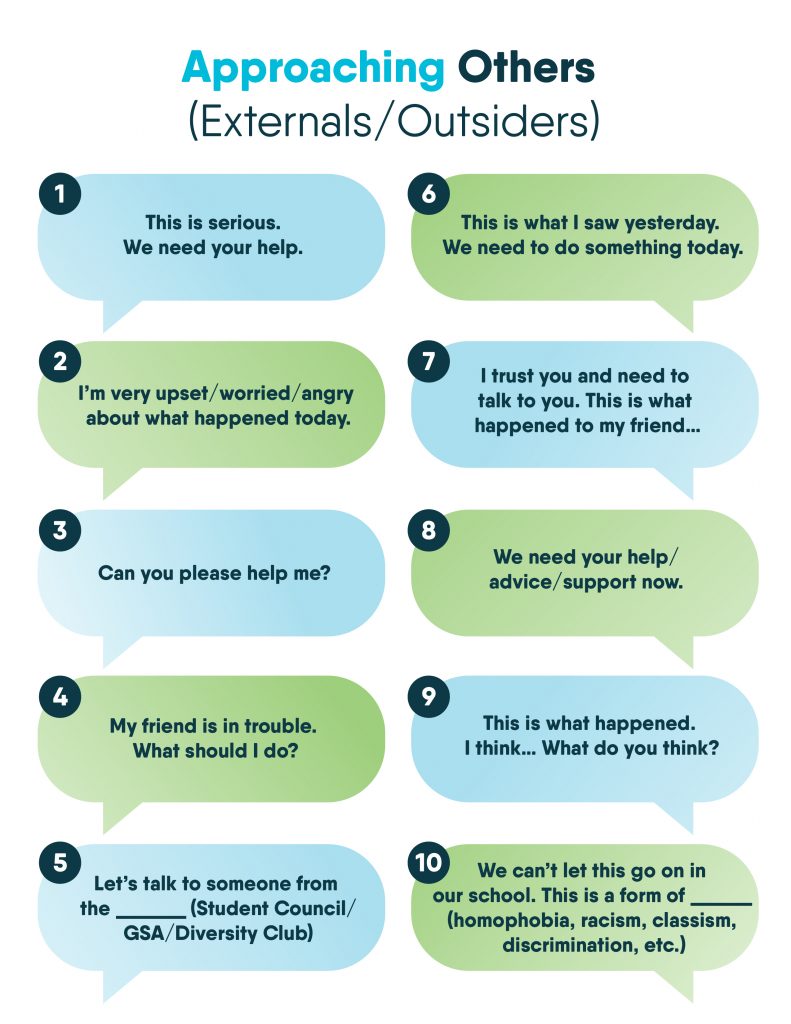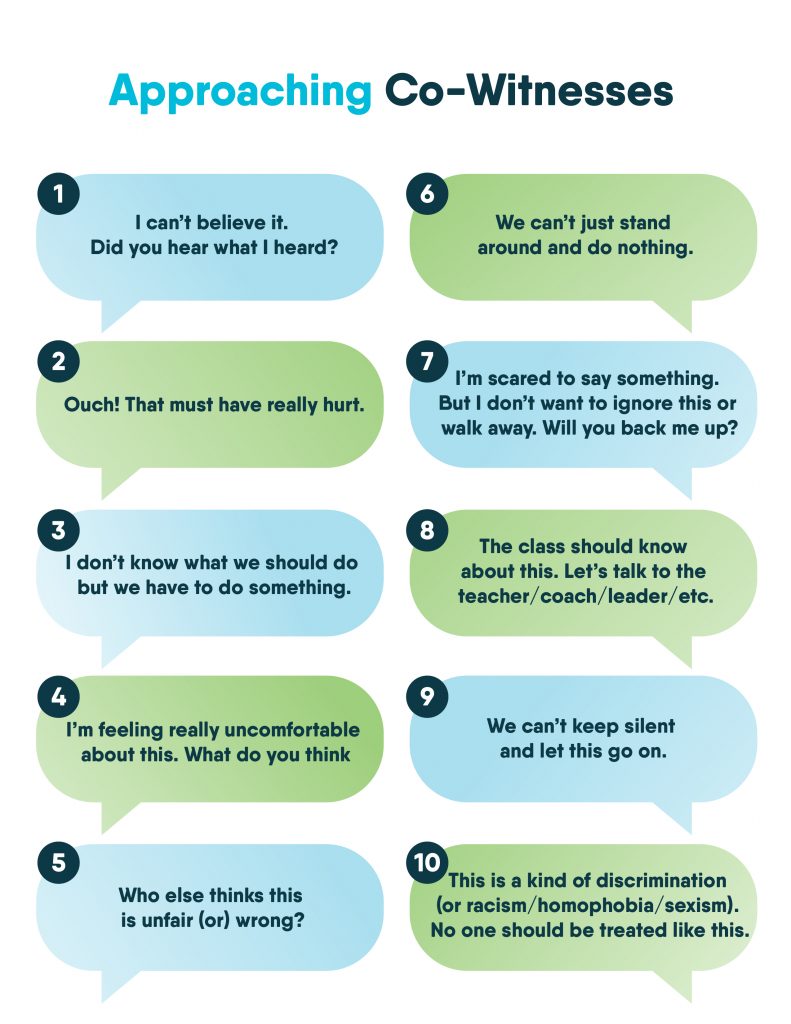Be an Active Witness
Have you ever seen someone treated unfairly because of their Race? Ethnicity? Culture? Religion? Gender? Ability? Age? Appearance? Sexual orientation? Gender Identity? Class?
Were you a silent bystander because you didn’t know what to do?
It is important to learn how to safely interrupt and intervene if you witness discrimination. This article explains how certain words and actions can help us de-escalate and defuse such an incident to prevent more harm.

Discrimination is the unfair or harmful treatment of people and groups based on characteristics such as race, ethnicity, culture, religion, gender, ability, age, appearance, sexual orientation, gender identity or class. To learn more, check out the Intro to Discrimination article.
It is common to feel afraid, unsure or upset when we witness a discriminatory incident. We may remember times we were silent to stay out of trouble or mind our own business. Many of us have been told not to “tattle” or “be a snitch”.
Speaking up for someone facing discrimination is not the same as tattling. If we are silent during a discriminatory incident, it sends the message that the behaviour is okay and the silence may also cause harm for those on the receiving end of discrimination. We can learn ways to respond that are appropriate and effective by learning to be an Active Witness.
What is Active Witnessing?
It is important to understand the differences between Bystanding and Witnessing. Bystanding is the act of ‘standing by’ during a hurtful or harmful incident; being there but not participating in the discriminatory act. Witnessing is a way of getting involved in a situation against discrimination. Active Witnessing empowers the witness to take action rather than just watching.
There are five main parties that may be involved in a discriminatory incident. As an Active Witness, you have four options of who to approach within this Witnessing Triangle to help defuse the situation.
- Self as a WITNESS: You have seen an incident and have the option to respond with appropriate words and actions
- The CO-WITNESS: Other observers of an incident who also have the option to respond
- The OFFENDER: The person making discriminatory remarks or behaviour towards the Receiver(s)
- The RECEIVER: The person receiving discriminatory remarks or treatment from the Offender(s)
- The EXTERNAL/ OUTSIDERS: Someone not present at the incident but may provide support and help (parent, family member, teacher, supervision aide, counsellor, principal, community member etc.)
Active Witnesses have developed the power and courage to safely interrupt and intervene during a discriminatory incident. They know how to use words and actions to de-escalate and defuse the situation to prevent more harm. They have learned a wide range of responses to use when someone is the target of discriminatory remarks or unfair treatment. Being an Active Witness takes a lot of courage and reflection to lead up to it.
There are many reasons that may prevent us from being Active Witnesses. Some reasons may include:
- Fear: Having thoughts such as “I’m afraid I’ll be the next target; I’m worried that my involvement will make the situation worse; I’m in shock and I can’t do anything.”
- Lack of skills: “I don’t know what to say or do, so I won’t get involved.” In the way that we practice earthquake drills and fire drills, our responses can be practiced so that we can develop the ‘muscle memory’ of appropriate words and actions.
- Socialization: We’ve been taught to stay out of trouble; mind our own business; it’s not my problem and not get involved in harmful situations.
- Implicit bias: A bias is cause to feel or show judgment for or against someone or something. If we are unaware of the biases that we may carry in ourselves about various people, they may surface during such situations (“I think the receiver deserves this treatment”).
- Colour blind: If we don’t see colour, we won’t see the inequities and injustices that Indigenous, Black or Persons of Colour (IBPOC) face and may not respond. This is linked to implicit or unconscious bias.
It’s important to learn how to deal with these feelings so we can respond in ways that will defuse the situation and prevent further harm. We can do this by learning about the Four Levels of Witnessing.
Four Levels of Witnessing
We can respond in different ways when we witness a discriminatory incident. The 4 Levels below are based on Dr. Ishiyama’s Active Witnessing Model.
You may react differently during situations depending on your safety, the seriousness of the situation and your feelings. It’s important to always consider your safety and the safety of those around you before engaging. The goal is to shift from a Level 1 or 2 response to a Level 3 or 4 in a safe and effective manner – to move from being a Dis-witness or a Passive Witness to a responsible Active Witness and Ethical Witness.
1. Dis-witnessing (Not hearing, Not seeing, Not feeling, Not Doing)
A Dis-witness may:
- Join the Offender and do things like laugh along at a discriminatory joke, use a racial slur or insult or tease someone
- Walk away without concern for the Receiver
- Avoid the situation or deny it happened
They may also say or think things like:
- I didn’t see anything wrong.
- I thought it was funny.
- No one was hurt so everything was fine.
- The Receiver deserved it.
- The Receiver was too sensitive or emotional.
- The Receiver could take care of themselves.
- I didn’t want to be noticed or get involved.
- I knew the Offender(s) and I had to support them.
- It was none of my business.
2. Passive Witnessing (Hearing, Seeing, Feeling but Not Doing)
A Passive Witness may:
- Be silent but may prepare or has the opportunity to prepare to be an Active Witness
- Feel afraid for their safety or freeze and be in shock
- Feel badly and unsure what to say or do or rely on others around to respond
They may also say or think things like:
- I was scared and in shock.
- I hoped someone else would deal with it.
- I thought the Receiver’s friends would come and help.
- I was afraid of getting involved.
- I was afraid of doing the wrong thing.
- I wasn’t sure if what I said would be helpful.
- I was so upset, I couldn’t think straight.
- I was confused.
- I wanted to help but I didn’t know what to do. (I don’t have the skills, confidence and experience.)
3. Active Witnessing (Hearing, Seeing, Feeling and Doing)
An Active Witness responds with appropriate words or actions. Their response may be immediate or delayed.
An Active Witness:
- Knows who to approach in the Witnessing Triangle
- Feels safe and confident to respond
- Is able to ‘call people in’ and ‘call people out’
You can ‘Call in’ the Offender by speaking to them privately:
- When there is time and a chance to ask questions and talk about how the Offender’s words and actions affect you and the Receiver
- To try to understand and learn about the Offender’s point of view
- To encourage a shift in thinking and behaviours
- To focus the conversation on seeing and thinking about what is happening and not just reacting
You can ‘Call out’ the Offender by speaking to them publicly:
- When we need to let someone know immediately that their words or actions are not acceptable and will not be tolerated
- When we need to intervene in order to prevent further harm
- When we need to interrupt the situation and decide what to do next
4. Ethical Witnessing (Moving beyond Hearing, Seeing, Feeling and Doing)
An Ethical Witness recognizes injustice and takes action. They deal with the situation and educate others. Their actions help to change our society and institutions for the better.
An Ethical Witness:
- Understands what discrimination looks like, sounds like and feels like
- Has the skills and confidence to use Active Witnessing responses
- Teaches others how to be Active Witnesses
To become an Active Witness:
- Learn what discriminatory remarks and treatment look like, sound like, feel like
- Commit to standing up to discrimination as a witness
- Develop empathy for the Receivers of the discrimination – to understand and care
- Learn the words you can use to speak up as an Active Witness
- Develop the skills and be prepared to use Active Witnessing responses effectively
- Understand the things that may prevent you from being an Active Witness
How can I Respond as an Active Witness?
When you witness discrimination, you can do your ‘PART’: Pause, Assess, Reflect & Talk/Tell
1. PAUSE: “HOW DO I FEEL?”
- Notice your feelings and emotions (fear, shock, anger, confusion sadness, etc.)
- Manage your feelings and emotions – Self-regulate (focus on your breath, count to 10, step away to reflect, seek support, etc.)
2. ASSESS: “AM I SAFE?”
Is the situation violent? Is there a chance that you may become a target?
- If there’s a chance you may be unsafe, do not approach the Offender. Active Witnessing does not mean that you must approach the Offender. You may choose to approach the Receiver, Co-witness or Externals/Outsiders to stay safe. If you find that you are afraid and it is not safe, there are other ways you can be an Active Witness so you don’t involve yourself directly.
Instead, you may:
- approach a Co-witness (someone else nearby) if that feels safe
- approach the Receiver if that feels safe
- seek support from an External/Outsider if that feels safe
If it is safe, ask yourself: “Will I respond now or later?”
- Now: Go to ‘Reflect’
- Later: Take some time to:
- self-regulate and manage your emotions
- think about the incident
- speak with someone who may support you and help you decide how to respond
3. REFLECT: “WHO DO I APPROACH AND WHAT DO I SAY?”
- “Who do I feel most comfortable approaching in the Witnessing Triangle?” (Co-witness, Receiver, External/Outsider, Offender)
- “What response will I use?” (interrupt, disagree, question, call it racism or discrimination, empathy, calling in or calling out)
Sample Active Witnessing Responses
4. TALK/TELL: “HOW SHOULD I SAY IT?”
- Approach the person you feel comfortable with (Co-witness, Receiver, External/Outsider, Offender)
- Take a deep breath, stand tall
- Use a calm, confident, assertive voice
- Be brief. De-escalate rather than escalate
- If you find that the situation has escalated and you no longer feel safe, take the time to back away and seek support from a Co-witness or External/Outsider if it feels safe
And remember:
An Active Witness understands the harmful impact of discrimination and knows how to respond to discriminatory remarks and hurtful situations. This requires much courage and practice. You will notice that each harmful incident you witness will differ and your emotions, confidence and responses will also vary. The more you practice Active Witnessing, the more you will develop the skills, courage and confidence to safely intervene. If we work together, we can break the silence and stand up to racism, discrimination and oppression in society.
We gratefully acknowledge Angela Ma Brown for sharing expertise in this subject matter in the development of the “Break the Silence: The Power of Active Witnessing program”, and Dr. Ishu Ishiyama for sharing research and expertise in the development of the Anti-discrimination Response Training (A.R.T.) model.
Tags: discrimination, social justice, advocacy, inclusivity, inclusion, anti-racism, anti-discrimination
Find out more about Foundry.
